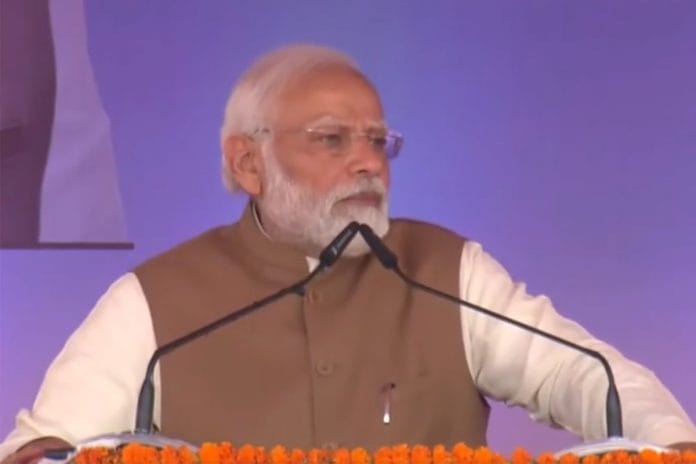New Delhi: With Prime Minister Narendra Modi flagging off the Bhopal-Delhi Vande Bharat Express Saturday, the number of the indigenous semi-high speed trains in India will be one short of a dozen.
Ever since its launch in 2019, the Vande Bharat Express has been a massive hit among travellers because it was believed to be faster and lighter than other trains, with a range of amenities – such as reclining seats, bio-vacuum toilets, and WiFi – that were once unheard of in Indian locomotives.
According to media reports, Railways minister Ashwini Vaishnaw confirmed last year that as many as 475 Vande Bharat Express trains have already been sanctioned and are expected to be delivered by 2025.
Beginning its journey from Rani Kamlapati Station at 5.40 am, the Bhopal-Delhi Vande Bharat Express will cut the travel time to 7-½ hours from 11 hours, reaching Delhi’s Hazrat Nizamuddin Station at 1.10pm. It will run six days a week, except Saturday.
The train with eight coaches and 530 seats reportedly finished its trial run 22 minutes ahead of the anticipated time, and it will formally be inaugurated and begin plying on 8 April.
Manufactured under the ‘Make in India’ initiative, these trains are also known as Train 18. Instead of having a separate coach for the engine, these have an integrated engine like a Bullet or a Metro, and so, are called ‘engine-less’ trains as well.
With an operational speed of 160 km/hr that can go up to 180 km/hr, these trains have air-conditioned chair coaches (economy and executive class) and are fitted with CCTV cameras for security. They also offer disabled-friendly spaces.
Also Read: Electric cabs are taking over Delhi’s roads, with 15-fold surge in registrations in 5 years
The beginning
The first of these trains was launched in February 2019 on the New Delhi-Kanpur-Allahabad-Varanasi route. It covered a distance of 771 km in eight hours as opposed to other trains that take 10-12 hours, with stops at Kanpur Central and Prayagraj Junction.
The same year in October, another Vande Bharat was inaugurated by Home Minister Amit Shah between New Delhi and Vaishno Devi, Katra, in Jammu and Kashmir, which cut travel time to eight hours from 12. It is also known to be India’s first vegetarian train and has stoppages in Ambala Cantt, Ludhiana and Jammu Tawi.
Vaishnaw also said last month that once the Udhampur-Srinagar-Baramulla Rail Link Project (USBRL) was completed, they would run a Vande Bharat Express between Jammu and Kashmir.
In September 2022, the third Vande Bharat Express was flagged off between Mumbai and Gandhinagar. According to reports, there were some changes in the newer model, with its weight being reduced by 38 tonnes to 392 tonnes, allowing it to function even with two feet-deep flood water on tracks. With stops at Surat, Vadodara Junction and Ahmedabad Junction, the train covers the distance between Gujarat and Maharashtra in under 6 hours—the fastest in India, which otherwise took about nine hours.
The same year, another train, from New Delhi to Amb Andaura in Himachal Pradesh, was introduced in October, reducing two hours of travel time and making stops at Ambala, Chandigarh and Anandpur Sahib.
In November 2022, Chennai-Mysuru Vande Bharat Express was flagged off. It covers the distance in 6-½ hours and stops at Katpadi and Bengaluru. Nagpur-Bilaspur and Howrah-New Jalpaiguri Vande Bharat Express were launched in December 2022.
This year itself, three Vande Bharat trains have begun operations. The Visakhapatnam-Secunderabad train runs with an average occupancy of nearly 140 per cent (because waitlisted passengers are also added). It covers the 699 km distance in 7 hours, 55 minutes, making stops at Warangal, Khammam, Vijayawada Junction and Rajahmundry.
Mumbai-Solapur and Mumbai-Sainagar Shirdi Vande Bharat were also made operational last month. On their launch, PM Modi was reported to have said that these trains connected economic centres such as Mumbai and Pune to centres of faith.
Not always a smooth ride
There have been major accidents involving the Vande Bharat Express. Apart from hitting cows and buffaloes that damaged its engine and other technical parts, the train also ran over a 54-year-old woman on the Mumbai-Gandhinagar route.
There had been some issues with littering that became so severe that Vaishnaw had to step in to instruct railway officials to change the cleaning system. There also have been incidents of failure due to defects in either wheels or due to stone-pelting where windows were broken.
(Edited by Smriti Sinha)






